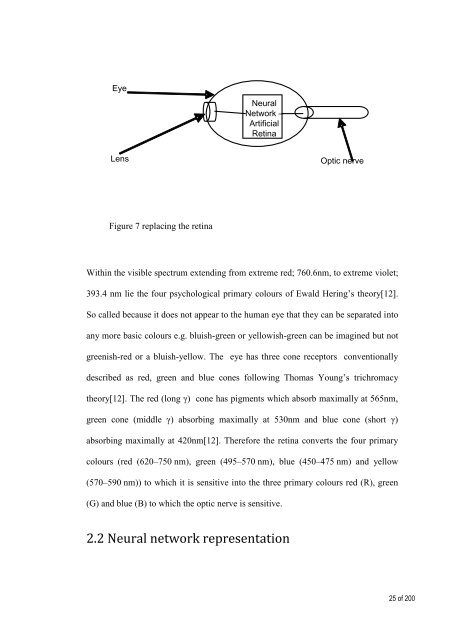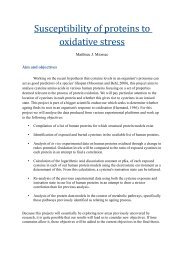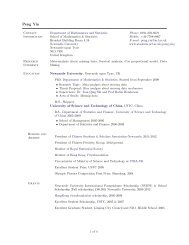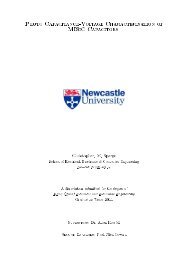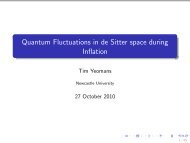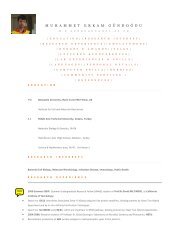- Page 1 and 2: An Address Event Representation (AE
- Page 3 and 4: Abstract\Foreword This document pro
- Page 5 and 6: Contents An Address Event Represent
- Page 7 and 8: --Appendix E FPGA Outputs .........
- Page 9 and 10: Figure 48 receiver rtl_16 .........
- Page 11 and 12: Chapter 1 Introduction/research aim
- Page 13 and 14: foveola (fovea pit) there is a one
- Page 15 and 16: NB that the photoreceptors of the f
- Page 17 and 18: electrodes to be driven implies sti
- Page 19 and 20: Typically AER is used as a multi se
- Page 21 and 22: Real time - innerpulse relationship
- Page 23 and 24: the post processing stage of this w
- Page 25: Appendix C: FPGA Sender chip Append
- Page 29 and 30: 1 0 1 1 0 0 1 1 0 1 1 1 Table 3 `xo
- Page 31 and 32: Adaptive linear combiner w 0 1 Let
- Page 33 and 34: is correct (one class) and -1 (the
- Page 35 and 36: x2 Linear separation 1.00 0.90 0.80
- Page 37 and 38: This is also the Cartesian co-ordin
- Page 39 and 40: 2.4 Comparison to Frame Based Repre
- Page 41 and 42: Typical GOP structure (Typically an
- Page 43 and 44: point is an event occurs for spike
- Page 45 and 46: 2.5.1 Files in Appendix A “ycut.m
- Page 47 and 48: MPEG-2 setup AER setup Camera Camer
- Page 49 and 50: 2.6.2 FPGA representation of epi_re
- Page 51 and 52: Chapter 3 Concepts An epiretinal im
- Page 53 and 54: AER Transmission lines INPUT image
- Page 55 and 56: electrical pulse generated is calle
- Page 57 and 58: Figure 25 Retinal colour processing
- Page 59 and 60: cells to modulate this luminance pa
- Page 61 and 62: L+ M- + - R-G G-R B-Y Y-B Note: L(r
- Page 63 and 64: 3.6.2 Retinal operations Light reac
- Page 65 and 66: quantified by number of cycles pres
- Page 67 and 68: (Where * is the convolution operato
- Page 69 and 70: T frame C * R * M p Tpacket i.e. Tp
- Page 71 and 72: e relaxed and from (2) the temporal
- Page 73 and 74: one tw o three four five six seven
- Page 75 and 76: 3.8.1 Other test images For other b
- Page 77 and 78:
Tspike (4ms) Ispike (16ms: interspi
- Page 79 and 80:
INDIGO ORANGE YELLOW MAGENTA CYAN B
- Page 81 and 82:
4.1 Sender concepts From chapter on
- Page 83 and 84:
pixel must equate to 0.02/1024 i.e.
- Page 85 and 86:
Clocking hierarchy (32 by 32 image)
- Page 87 and 88:
the number of address bits will alt
- Page 89 and 90:
Translation report, (3) Map report,
- Page 91 and 92:
90 of 200 CLKIN_IN RST_IN pixelcloc
- Page 93 and 94:
incorporate colour planes for each
- Page 95 and 96:
Chapter 5 Receiver chip The followi
- Page 97 and 98:
5.2 Power Analysis Xilinx FPGAs hav
- Page 99 and 100:
98 of 200 produce_wire _outputs Ins
- Page 101 and 102:
5.5.1 Incoming (short) AER stream T
- Page 103 and 104:
Receiver Red plane r1 DAC (4-bit) T
- Page 105 and 106:
5.8.2 Electrode size and positionin
- Page 107 and 108:
sequence of wiring from the receive
- Page 109 and 110:
does this is to inject an equivalen
- Page 111 and 112:
6.2.2 Envisaged retinal array This
- Page 113 and 114:
a monochrome camera in this space i
- Page 115 and 116:
632mW) thus extending battery life
- Page 117 and 118:
For the implemented/structural case
- Page 119 and 120:
The sender and receiver circuitry p
- Page 121 and 122:
Bibliography 1. Woodburn R. Murray
- Page 123 and 124:
38. Banks, D.J., P. Degenaar, and C
- Page 125 and 126:
74. Freeman, J.A., Skapura, D. M.,
- Page 127 and 128:
109. Weiland, J.D., et al. Progress
- Page 129 and 130:
141. Indiveri G. Chicca E. Douglas
- Page 131 and 132:
172. Singh, P.R., et al. A matched
- Page 133 and 134:
206. Stieglitz, T., et al. Developm
- Page 135 and 136:
xmixedsource; numberOfFrames = 8; f
- Page 137 and 138:
%check {k} =imread (['D:\abc\subima
- Page 139 and 140:
%Two for loops the first (outer loo
- Page 141 and 142:
%Row break rr6c1=000; rr6c2=000; rr
- Page 143 and 144:
--Appendix B FPGA Test setup librar
- Page 145 and 146:
stream_blue_pulse_count: out std_lo
- Page 147 and 148:
DVI_XCLK_P clock_25MHz, spike_cloc
- Page 149 and 150:
use IEEE.STD_LOGIC_UNSIGNED.ALL; --
- Page 151 and 152:
--Appendix C FPGA Sender chip libra
- Page 153 and 154:
-- else -- resit '1', CLKDV_OUT =>
- Page 155 and 156:
FPGA Receiver (structural) chip --A
- Page 157 and 158:
FPGA Receiver (structural) chip --E
- Page 159 and 160:
FPGA Receiver (structural) chip --r
- Page 161 and 162:
FPGA Receiver (structural) chip blu
- Page 163 and 164:
FPGA Receiver (structural) chip con
- Page 165 and 166:
FPGA Receiver (structural) chip --s
- Page 167 and 168:
FPGA Receiver (structural) chip --
- Page 169 and 170:
FPGA Receiver (structural) chip --
- Page 171 and 172:
FPGA Receiver (structural) chip IO_
- Page 173 and 174:
Number with an unused LUT 18 219 8%
- Page 175 and 176:
IO Utilization: Number of IOs: 26 N
- Page 177 and 178:
The Slice Logic Distribution report
- Page 179 and 180:
Router effort level (-rl): Standard
- Page 181 and 182:
oming_clock | HOLD | 0.519ns| | 0|
- Page 183 and 184:
Part | xc5vlx50tff1136-3 | Process
- Page 185 and 186:
Selected Device: 5vlx50tff1136-3 Sl
- Page 187 and 188:
used in combination with MAP -timin
- Page 189 and 190:
Data Sheet report: ----------------
- Page 191 and 192:
“For these implantable devices to
- Page 193 and 194:
microstimulator with a 1:4 demultip
- Page 195 and 196:
“Medical experiments have estimat
- Page 197 and 198:
A Retinomorphic Vision System “In
- Page 199 and 200:
“The common language of neuromorp


